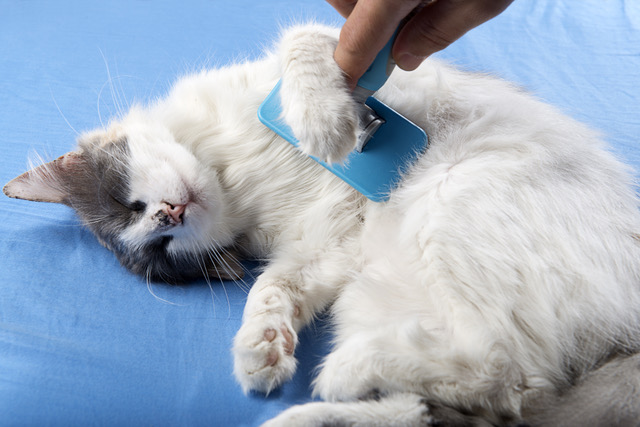
Grooming Cat
Many cat caretakers assume that since their cat grooms themselves that they do not need to be brushed.
But the truth is, there are many benefits to brushing your cat either daily or several times a week – one of the primary being it is a wonderful time for you to bond and spend time with your cat.
Brushing helps keep your cat’s coat in top condition, a great time for you to check for fleas, lumps, bumps, skin irritations, wounds and sores. brushing not only helps keep kitty’s coat in good shape. It’s also helpful in decreasing or eliminating hair balls.
The amount of brushing your kitty’s coat needs depends on the type and texture of the fur, as well as your pet’s age, lifestyle and health status.
Some cat fur requires a lot of brushing. You can tell if your cat requires brushing if their coat becomes tangled or knotted.
Older cats may lose interest in grooming themselves, especially if they are experiencing age-related dementia and will therefore benefit from brushing.
Overweight kitties often have a difficult time grooming.
Fortunately, many kitties absolutely love being brushed or combed, and many who are initially hesitant can learn to enjoy the process as well.
Tips for Brushing Your Cat
1. Choose the right location
It’s really important to brush your cat in a location where she feels safe and comfortable, and on a surface that is stable. Obviously the sturdiest surface is the floor and sweeping up any fur that comes off your cat will be easy
If you’re not able to sit or kneel on the floor, the next best option might be a bed or couch, which you’ll probably want to drape with an old sheet or towel before you start to make clean up easy.
2. Choose the right tools
Suggestions:
Slicker brush (a brush with many tiny metal bristles)
A soft, natural bristled brush
A slicker brush is usually the best tool for getting through the coat, but your cat may prefer the sensation of another type of brush (a soft bristle or rubber brush, for example) or even a comb. Some people use both a slicker brush and a second brush or comb, alternating between the two.
Typically, your cat will move a short distance away when he’s had enough of one brush, which is a good time to switch to the second brush. Don’t forget to clean the hair from the brushes frequently during each grooming session – you don’t want to transfer dead fur or debris back to your cat.
To keep your cat at ease and calm try diffusing a little lavender or a calming blend. Diffuse or apply the essential oil about 30 minutes prior to brushing. If your cat does not like when essential oils are diffused then apply them to yourself and act as a human diffuser.
3. Have treats ready
For some cats giving them a treat as a reward is beneficial. If your cat is one of them, make sure you have treats sitting right next to your grooming tools before you begin.
4. Start slow and brush lightly
If you’re brushing or combing your cat for the first time, schedule grooming sessions at about the same time each day, and if kitty balks at the brush, just offer treats for the first few days without attempting to groom him or her.
The goal is to teach her to associate the location, the tools, and being brushed with good feelings, treats and being pampered.
After a few days of treats and petting in the grooming location, hold the brush near her and when kitty approaches it, reward her with a treat. Gradually increase this type of interaction until your cat will allow you to very lightly brush the top of her head.
If your cat is nervous, begin going through the motions of brushing with the non-bristled side of the brush (I call this “ineffective grooming,” but it’s oftentimes necessary to desensitize nervous kitties with sensitive skin). By initially flipping the brush over, you reinforce that this new ritual doesn’t hurt, and comes with goodies.
After a few sessions of very gentle brushing, try running the brush very lightly down her neck and to other areas of her body. Be sure to keep the brush in constant steady contact with her to help her feel secure as you groom her. If your cat has old mats it’s best to trim them out before attempting maintenance brushing, as pulling hair will result in an uncooperative kitty, and will decrease the likelihood of cooperation in the future.
If your cat is severely matted, I recommend have a professional groomer shave the mats out, then work on brush desensitization as the hair grows in. Preventing mats from occurring is much easier than trying to brush them out after they’ve occurred.
After brushing your cat wipe their coat with a moistened towel to remove any extra fur and apply a very small amount of Fractionated Coconut Oil to keep their skin and coat soft.
